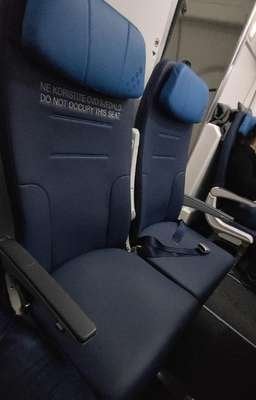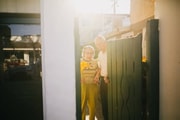Flight Attendants Bewildered: This Mysterious Plane Seat Photo Is Leaving Everyone Guessing - Can You Figure It Out?
By
Danielle F.
- Replies 1
The world of air travel is full of mysteries and peculiarities that can leave even the most seasoned travellers scratching their heads. One such enigma recently took the internet by storm when a photo of a seemingly forbidden plane seat was shared by a perplexed passenger. The image, which quickly garnered widespread attention, showed a seat with a clear directive stitched into the fabric: 'Do not occupy this seat.' The seat in question was 31E, located in the back row of a Croatia Airlines Airbus A220-300.
The passenger, who had never encountered such a sight before, was informed by a flight attendant that the seat lacked a seat belt. This explanation, however, did not satisfy the passenger's curiosity, as the mounting for the belt was visibly present. 'Made no sense for me because the mounting for the belt was there. Should have been easier to fix a seat belt than do that stitching work,' the passenger mused in his Facebook post.
This peculiar situation sparked a flurry of speculation among social media users. Some guessed that the seat might be reserved for cabin crew or other airline workers, while others thought it could be designed to provide additional space for passengers with special requirements. The intrigue was palpable as comments poured in: 'Hopefully someone will know what this is about because I’ve never seen that,' one person wrote. Another eagerly awaited an explanation: 'Can’t wait for someone to explain.'
The official seating map for Croatia Airlines added to the mystery by showing a blank space where seat 31E should be. But as it turns out, the reason behind the forbidden seat is rooted in safety regulations. Airbus, the aircraft manufacturer, clarified to Croatian outlet AvioRadar that the plane was designed to accommodate only 149 seats. If the 150th seat were to be used, the aircraft would require two additional over-wing exits to comply with safety standards.
But the curiosities of aircraft seating don't end there. The seating map also reveals that row 13 is conspicuously absent, a practice that is not uncommon in the airline industry. Superstition plays a significant role in this decision, as many cultures consider the number 13 to be unlucky. German airline Lufthansa, for instance, omits both rows 13 and 17 from their aircraft. The airline has explained that this is a nod to passengers with superstitions, ensuring that no one is forced to sit in a row they believe to be unlucky.
The number 17 also carries superstitious weight. When written as the Roman numeral XVII, its anagram is VIXI, which in Latin can be interpreted as 'I have lived,' implying 'my life is over.' Lufthansa notes that in some countries, such as Italy and Brazil, the number 17 is considered unlucky, not 13.
These fascinating tidbits about airline practices offer a glimpse into the complexities of air travel and the lengths to which airlines will go to ensure passenger comfort and safety—even if it means leaving a seat empty or skipping entire rows. It's a reminder that there's always more to discover when we take to the skies.

So, dear members of the Seniors Discount Club, have you ever come across a similar travel mystery? Or perhaps you have your own superstitions when it comes to flying? Share your stories and thoughts in the comments below—we'd love to hear about your high-flying experiences and any other peculiar plane seat encounters you've had!
The passenger, who had never encountered such a sight before, was informed by a flight attendant that the seat lacked a seat belt. This explanation, however, did not satisfy the passenger's curiosity, as the mounting for the belt was visibly present. 'Made no sense for me because the mounting for the belt was there. Should have been easier to fix a seat belt than do that stitching work,' the passenger mused in his Facebook post.
This peculiar situation sparked a flurry of speculation among social media users. Some guessed that the seat might be reserved for cabin crew or other airline workers, while others thought it could be designed to provide additional space for passengers with special requirements. The intrigue was palpable as comments poured in: 'Hopefully someone will know what this is about because I’ve never seen that,' one person wrote. Another eagerly awaited an explanation: 'Can’t wait for someone to explain.'
The official seating map for Croatia Airlines added to the mystery by showing a blank space where seat 31E should be. But as it turns out, the reason behind the forbidden seat is rooted in safety regulations. Airbus, the aircraft manufacturer, clarified to Croatian outlet AvioRadar that the plane was designed to accommodate only 149 seats. If the 150th seat were to be used, the aircraft would require two additional over-wing exits to comply with safety standards.
But the curiosities of aircraft seating don't end there. The seating map also reveals that row 13 is conspicuously absent, a practice that is not uncommon in the airline industry. Superstition plays a significant role in this decision, as many cultures consider the number 13 to be unlucky. German airline Lufthansa, for instance, omits both rows 13 and 17 from their aircraft. The airline has explained that this is a nod to passengers with superstitions, ensuring that no one is forced to sit in a row they believe to be unlucky.
The number 17 also carries superstitious weight. When written as the Roman numeral XVII, its anagram is VIXI, which in Latin can be interpreted as 'I have lived,' implying 'my life is over.' Lufthansa notes that in some countries, such as Italy and Brazil, the number 17 is considered unlucky, not 13.
These fascinating tidbits about airline practices offer a glimpse into the complexities of air travel and the lengths to which airlines will go to ensure passenger comfort and safety—even if it means leaving a seat empty or skipping entire rows. It's a reminder that there's always more to discover when we take to the skies.
Key Takeaways
- A passenger noticed a seat (31E) marked as 'Do not occupy' on a Croatia Airlines Airbus A220-300 and shared the puzzling image online.
- It was speculated that the forbidden seat could be reserved for crew or to provide additional space, but actually, it is due to, safety regulations.
- Airbus explained that only 149 seats could be in service to avoid the requirement of additional over-wing exits if a 150th seat were used.
- The article also notes cultural avoidance of certain numbers, such as 13 and 17, which explains why some airline seating skips these row numbers to accommodate superstitions.








